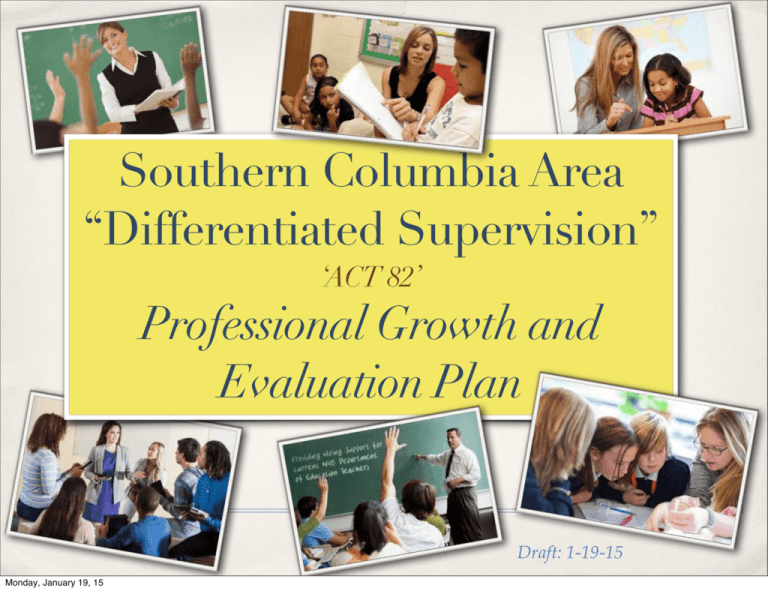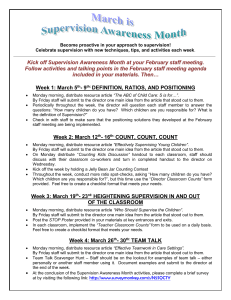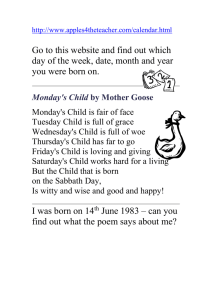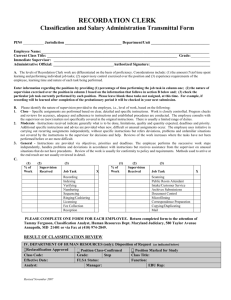Professional Growth and Evaluation Plan
advertisement

Southern Columbia Area “Differentiated Supervision” ‘ACT 82’ Professional Growth and Evaluation Plan Draft: 1-19-15 Monday, January 19, 15 Professional Growth and Evaluation Plan Developed using guidelines and recommendations from PDE (specific) Developed by collaborative efforts of administrators and IU Specialists across the state and PDE as required for Act 82 Most district (local) plans include similar elements found within our plan Refined by the entire SCA administrative team Currently D-R-A-F-T; proposed for board approval in February Monday, January 19, 15 “Supervision” vs “Evaluation” Supervision is an organizational function concerned with promoting teacher growth, leading to improvement in teaching performance and greater student learning. ~~~~~~~~~~~~~~~~~~~~~~~~~~~~~~~~~~~~~~ Evaluation is an organizational function designed to make comprehensive judgments concerning teacher performance and competence for the purposes of personnel decisions such as tenure and continuing employment. Monday, January 19, 15 Professional Growth and Evaluation System includes the following 10 elements: Based on the 4 Domains of Danielson’s “Framework for Teaching”. Training for administrators and teachers that creates: • A common language - “What is good teaching?” • Develops the skills of collecting evidence, data analysis & reflection • Increase data-driven discussions among professionals Formal observation - evidence-based assessment to improve teaching. Administrators and professional teaching staff will collaborate to develop and monitor a plan for professional growth. A professional growth cycle with the formal observation as a multiyear process of professional growth and continual reflection on goals. Professional development involves collaborative learning culture for teachers, integrating individual or collegial goals into school goals, and utilizing student achievement and other data about student results. Monday, January 19, 15 Professional Growth and Evaluation System includes the following 10 elements: A process using Formal Observation and Self/Team-Directed Professional Development data to ultimately determine a summative, semi-annual or annual evaluation for every employee based on the Danielson Framework and direction from P.D.E. The Professional Growth and Evaluation Plan for Teachers focuses on the enhancement of teacher performance and student learning. The program will recognize the varying needs of each staff member at each career stage as well as a variety of methods for the plan’s implementation. This program will offer support, remediation, enrichment and incentive for each staff member to develop the skills necessary to ensure quality education for all students. Monday, January 19, 15 #1 5 1 4 1 0 2 1 # e l c y C s in ’ n o o i h t a W v r e s b O l a m For l? e d o M Monday, January 19, 15 FORMAL OBSERVATION MODEL (Non-Tenured & First Year In-District Tenured) Definition: Formal Observation is a mode of supervision that enables the teacher to work with his/her supervisor for the purpose of improving the teaching/learning environment by focusing on pedagogy, methodologies, resources, and techniques. Working through the collaborative process, the teacher and supervisor can foster a climate to bring about instructional improvement. This mode includes a pre-observation conference, a formal observation, and a post-observation conference to determine areas for growth and serve as data for the summative evaluation. Monday, January 19, 15 #2 5 1 4 201 3 2 # le c y C n i s ’ o d e t Wh a i t n e r e f f Di n o i s i v Super l? e d o M Monday, January 19, 15 #3 e v i s n Inte / w n o si i v r e n o i t Sup a rv e s b O l a m For ? l e d Mo Monday, January 19, 15 5 1 4 1 d 20 e t a i t n e r e f f i D “ s ”? i e t d a o h M W n o i s i v r e p Su QUESTIONS TO ASK: 1. What’s you professional goal? 2. What domain/component of Danielson’s will be addressed? 3. Do you go it alone or with a team? 4. What PD relate to your goal? 5. Will you GAIN, REFINE or CREATE knowledge? Monday, January 19, 15 2014-15 Teachers in Formal Evaluation Cycles 2014-15 There will be 33 Teachers in Formal Evaluation Model Cycle #2 & #3 will be in Differentiated Supervision Model 2015-16 There will be 34 Teachers in Formal Evaluation Model Cycle #1 & #3 will be in Differentiated Supervision Model 2016-17 There will be 33 Teachers in Formal Evaluation Model Cycle #1 & #2 will be in Differentiated Supervision Model Monday, January 19, 15 Self-Directed or Team-Directed Professional Growth Model (Proficient or Distinguished Tenured Teachers) TEACHERS MUST: Have tenure. Have received two consecutive, summative ratings of proficient or distinguished. Receive approval from their designated supervisor Conduct a mid-year review with the supervisor to monitor progress toward goal. Conduct an end of year review with the supervisor to reflect on this year’s goal and share initial thoughts for a goal for the following school year, if applicable. Monday, January 19, 15 GOAL SETTING: SELF-DIRECTED & TEAM-DIRECTED MODELS (Proficient or Distinguished Tenured Teachers) DIFFERENTIATED SUPERVISION Choose between two models: Self-directed or Team-directed Opportunity for teachers to identify a professional goal aligned to a domain and component from the Danielson Framework Focused PD, with aim of increasing student achievement Teacher’s professional development activities should apply to the Danielson Framework for Teaching, and other professional evidence collected throughout the year; used to inform the teacher’s summative evaluation. PLEASE NOTE: All steps in the “DS”Model will be documented within the District’s PAETEP (PA Electronic Teacher Evaluation Portal) Monday, January 19, 15 3 Types of ‘D.S.’ Goals Goal setting is an essential component of both the Selfdirected and Team-directed models. TYPE 1: TEACHING GOALS... Built around teacher behaviors that are directly related to student outcomes. TYPE 2: LEARNER GOALS... Relate directly to solving a specific learning problem or improving some particular student deficit. TYPE 3: PROGRAM GOALS... Relate to curriculum areas, course outlines, articulation activities, materials selection, and so on... Monday, January 19, 15 Action Research Focus Options Student Focus: Identification and investigation of concerns in the Cognitive, Behavioral, Social/Emotional, Psychomotor domains of the student. These concerns are issues which arise from daily interaction with student(s). Teaching Practice Focus Research projects driven by questions or concerns with a specific aspect of teaching practice This could include the questioning of existing practice or situations then exploring new ways to address the concern. Teacher Focus The questioning congruence between teacher beliefs and actual teacher practice. Focuses upon work habits, personality traits, career stage developments or another personal aspect of teaching. Curriculum Focus May focus on a specific aspect of the existing curriculum or implementation of a new curriculum as approved by the curricular supervisor. School Organization Focus This is usually collaborative in nature and examines structures, policies, traditions, and procedures in existence. This focus breaks the shackles of tradition and leads to re-thinking and change within the school. Monday, January 19, 15 “Other” Options for Non-Core Staff ‘OTHER’ DIFFERENTIATED SUPERVISION MODELS LESSON STUDY: Description - Goes beyond collaboration and includes co-planning and observing actual lessons with a a focus on student thinking. Teachers will plan, observe and refine “research lessons” designed to make real their long-term goals for student learning and development. PEER COACHING: Description – Enables a staff member to work with a peer teacher in a clinical setting to examine, refine and enhance professional performance. The peers work in a collaborative relationship that involves the teacher identifying the area of study for the peer coach and then together conducting a series of pre-conferences, observations, and post-conferences. PROCESS PORTFOLIO: Description – Teachers working to master the use of performance assessment in their classroom may choose to experience the process themselves in this option. Portfolios begin with a focus question and progress to plan to answer that question. REFLECTION JOURNAL: Description – Provides a framework for writing thoughts and perceptions relating to instructional and educational experiences. Journaling is designed to promote the processing of those experiences. Time for reflection fosters analysis. Journal formats may include a variety of forms: free writing, interactive journals, reaction, contemplation, elaboration, or cause and effect. Reflective journal entries will be submitted monthly to the supervisor. Monday, January 19, 15 More! “Other” Options for Non-Core Staff ‘OTHER’ DIFFERENTIATED SUPERVISION MODELS TEACHER – COMMUNITY PARTNERSHIP: Description – This option allows teaches to collaborate with a business, community group or institution to extend the school to community partnership for the benefit of students and/or the identified partner. VIDEO TAPE ANALYSIS: Description – This option is to provide an avenue to view, create or listen to lessons with the focus on analysis and identification of areas of strength as well as strategies that might be executed differently. VISITATIONS: Description – This option is to provide the professional employee the opportunity to observe other classrooms or programs outside of the district for a specific purpose. WRITING FOR PUBLICATION: Description – This option offers the opportunity and encouragement for professionals to produce a written document based on research, experience, observation and/or data analysis. It can clarify thinking and offer other useful information to enhance teaching and learning. Reminder: All DS proposals must be approved by the direct supervisor and developed, communicated, documented and approved through the PA-ETEP. Monday, January 19, 15 PA-ETEP PORTAL (1) Supervisors and teachers will access their Differentiated Supervision Plan Module from the evidence the district’s PA-ETEP portal. All observation documentation, communication, approval & final rating is now done through the ETEP. (2) Teachers will choose a “Type of Differentiated Supervision” from the drop down menu.(See Above) Monday, January 19, 15 PA-ETEP PORTAL (3) Teachers must choose 2-3 “Component Focus” from Danielson’s 4 Domains from the drop down menu.(See Below) (4) Selected components (Danielson)should be selected specifically to align with each teachers’ intended “Differentiated Supervision” goals. Monday, January 19, 15 PA-ETEP PORTAL Below are 5 areas that teachers need to complete to provide explicit details about their selected “DS” Action Plan in each text box provided. PROJECT GOAL: Describe the goal for the Differentiated Supervision Action Plan. PURPOSE/RATIONALE: Describe the rationale for selecting and implementing your Differentiated Supervision Action Plan. STEPS &/OR ACTIVITIES TO ACHIEVE GOAL: Describe the various steps and/ or activities that will be involved in completing your Differentiated Supervision Action Plan. IMPLEMENTATION TIMELINE: Describe how you will implement your Differentiated Supervision Action Plan over the course of the school year. INDICATORS OF EFFECTIVENESS/MEASURES OF STUDENT SUCCESS: Describe what you will use to measure student success and/or the effectiveness of your “DS” Plan and be selected specifically to align with your intended “DI” goals. Monday, January 19, 15 IN SUMMARY.... “D.S.” is designed to promote teacher growth, leading to improvement in teaching performance... and increased student learning The PA-ETEP (Electronic Teacher Evaluation Portal) will be used for all Professional Artifacts: Walk-Throughs, Formal Observations, SLO (Student Learning Objectives) and “DS” (Differentiated Supervision), Act 82-1 Evaluation Form District supervisor will be meeting with individual teachers, departments/grade levels this week to get Cycle 2 or 3 started. Cycle 1 staff in the Formal Observation Model will do the same as last year in E-TEP. A copy of the district’s “Professional Growth & Evaluation Plan” is now available on the CIT web site. (DRAFT) Monday, January 19, 15






